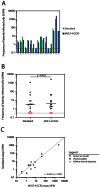Rapid quantification of the latent reservoir for HIV-1 using a viral outgrowth assay
- PMID: 23737751
- PMCID: PMC3667757
- DOI: 10.1371/journal.ppat.1003398
Rapid quantification of the latent reservoir for HIV-1 using a viral outgrowth assay
Abstract
HIV-1 persists in infected individuals in a stable pool of resting CD4(+) T cells as a latent but replication-competent provirus. This latent reservoir is the major barrier to the eradication of HIV-1. Clinical trials are currently underway investigating the effects of latency-disrupting compounds on the persistence of the latent reservoir in infected individuals. To accurately assess the effects of such compounds, accurate assays to measure the frequency of latently infected cells are essential. The development of a simpler assay for the latent reservoir has been identified as a major AIDS research priority. We report here the development and validation of a rapid viral outgrowth assay that quantifies the frequency of cells that can release replication-competent virus following cellular activation. This new assay utilizes bead and column-based purification of resting CD4(+) T cells from the peripheral blood of HIV-1 infected patients rather than cell sorting to obtain comparable resting CD4(+) T cell purity. This new assay also utilizes the MOLT-4/CCR5 cell line for viral expansion, producing statistically comparable measurements of the frequency of latent HIV-1 infection. Finally, this new assay employs a novel quantitative RT-PCR specific for polyadenylated HIV-1 RNA for virus detection, which we demonstrate is a more sensitive and cost-effective method to detect HIV-1 replication than expensive commercial ELISA detection methods. The reductions in both labor and cost make this assay suitable for quantifying the frequency of latently infected cells in clinical trials of HIV-1 eradication strategies.
Conflict of interest statement
The authors have declared that no competing interests exist.
Figures





References
-
- Gulick RM, Mellors JW, Havlir D, Eron JJ, Gonzalez C, et al. (1997) Treatment with indinavir, zidovudine, and lamivudine in adults with human immunodeficiency virus infection and prior antiretroviral therapy. N Engl J Med 337: 734–739. - PubMed
-
- Hammer SM, Squires KE, Hughes MD, Grimes JM, Demeter LM, et al. (1997) A controlled trial of two nucleoside analogues plus indinavir in persons with human immunodeficiency virus infection and CD4 cell counts of 200 per cubic millimeter or less. AIDS Clinical Trials Group 320 Study Team. N Engl J Med 337: 725–733. - PubMed
-
- Perelson AS, Essunger P, Cao Y, Vesanen M, Hurley A, et al. (1997) Decay characteristics of HIV-1-infected compartments during combination therapy. Nature 387: 188–191. - PubMed
-
- Chun TW, Finzi D, Margolick J, Chadwick K, Schwartz D, et al. (1995) In vivo fate of HIV-1-infected T cells: quantitative analysis of the transition to stable latency. Nat Med 1: 1284–1290. - PubMed
-
- Chun TW, Carruth L, Finzi D, Shen X, DiGiuseppe JA, et al. (1997) Quantification of latent tissue reservoirs and total body viral load in HIV-1 infection. Nature 387: 183–188. - PubMed
Publication types
MeSH terms
Substances
Grants and funding
LinkOut - more resources
Full Text Sources
Other Literature Sources
Medical
Research Materials

